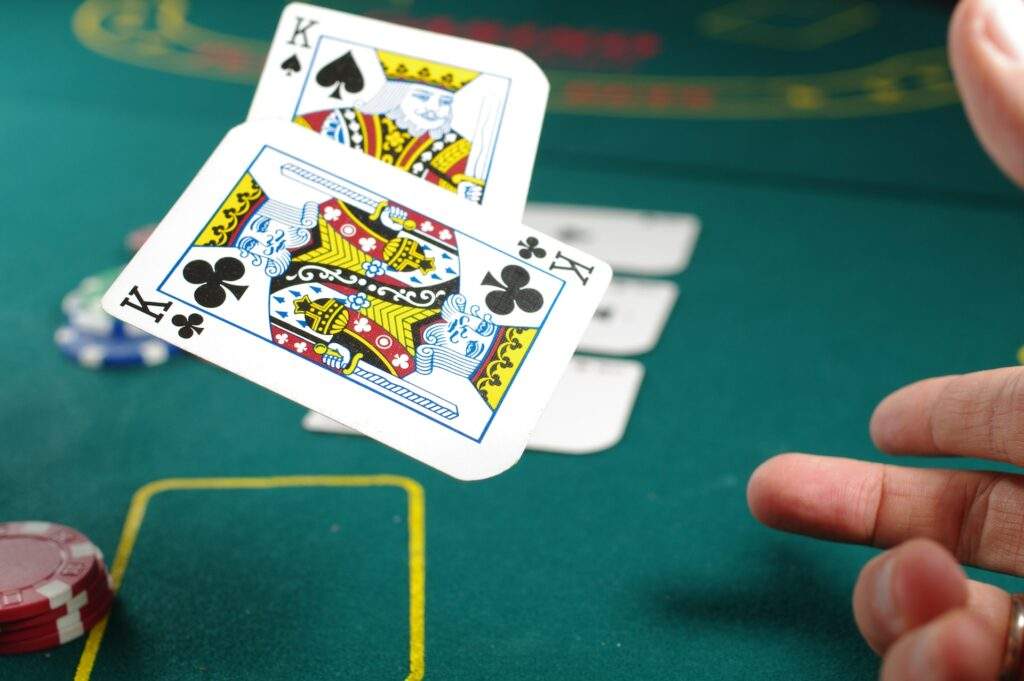Introduction:
Pot-Limit Omaha (PLO) is a high-action variant of poker that has gained immense popularity in recent years. Known for its adrenaline-pumping gameplay and massive pots, PLO offers a unique and thrilling experience for poker enthusiasts. In this article, we explore the dynamics of Pot-Limit Omaha, from its rules and gameplay to advanced strategies that will help you navigate this fast-paced variant with confidence. Get ready to unleash the power of four-hole cards and experience the excitement of Pot-Limit Omaha.
When it comes to the rules, Pot-Limit Omaha follows the same general structure as Texas Hold’em with a few key differences. In this variation of poker, each player is dealt four hole cards (as opposed to two in Texas Hold’em) to create their five-card hand. Bets are capped at the size of the current pot and each player is allowed to bet up to three times the pot on each street. This is one of the key differences from Texas Hold’em and helps to create a more aggressive betting round. Additionally, four of the five community cards must be used to construct a player’s final hand, meaning even the most conservative players can rack up some serious chips.
Another major difference between PLO and Texas Hold’em is the type of hand that will usually win at a showdown. In PLO, hands like flush draws, high-card hands, and two pairs are much more common than they are in Texas Hold’em and players must play a wider range of hands to be successful. This means that PLO is generally considered a much more action-oriented game than Texas Hold’em, largely due to the huge betting rounds and a greater number of playable hands. As a result, the pots in Pot-Limit Omaha are regularly much larger than in Texas Hold’em, making it a thrilling game for both cash games and tournaments.

Understanding the Basics of Pot-Limit Omaha:
Pot-Limit Omaha is similar to Texas Hold’em, but with a few key differences that add an extra layer of complexity and excitement to the game. Here’s an overview of the key elements:
Four Hole Cards:
In Pot-Limit Omaha, each player is dealt four private cards (hole cards), compared to the two hole cards in Texas Hold’em. However, players must use exactly two of their hole cards, combined with three community cards, to make the best possible hand.
All forms of Omaha, including Pot-Limit Omaha, are usually played with five community cards available for all players to use. Once the flop has been dealt (which consists of three community cards), the second betting round begins. Here, players will have the opportunity to bet any amount between the minimum and maximum bet sizes. The turn and river (the last two community cards dealt) will follow, with another round of betting in between. Once all the cards are out and all bets are checked, players will reveal their hands and the pot will be awarded to the player with the strongest five-card hand.
In case of a tie between two players, the pot will be split between both players. Additionally, in Omaha variations, players must also use two of their hole cards to make a qualifying hand. This means that even though players may have five or more cards available to them, they can only make their winning hand using two of their hole cards and three cards from the community board.
The Flop, Turn, and River:
Pot-Limit Omaha follows the same structure as Texas Hold’em when it comes to the community cards. After the pre-flop betting round, the dealer reveals the flop (three community cards), followed by a round of betting. Then, the turn (fourth community card) is revealed, and another round of betting ensues. Finally, the river (fifth community card) is revealed, leading to the last round of betting.
After the river round, the best five-card poker hand out of the seven available to each player is determined. The player with the best hand will take the pot. If two or more players have the same ranking hand, the pot will be split between those players.
The players must agree on how the pot will be split if two or more players have the same ranking hand. It is possible for the pot to be agreed to be split completely equally, or for it to be split based on certain hands given a numerical value. Additional cards can be dealt if the pot cannot be split satisfactorily for all players.
Hand Formation and Showdown:
In Pot-Limit Omaha, the best hand is determined by combining exactly two hole cards with three community cards. Players must carefully consider the potential combinations they can make with their hole cards to form the strongest possible hand. At the showdown, the player with the best hand wins the pot.
It is important to note that in Pot-Limit Omaha, straights and flushes count against players in determining the winning hand. This means that a flush of a higher suit will beat a lower flush, and a straight of a higher number will beat a lower straight. Therefore, it is key for players to remember how to count flush and straight combinations when picking their starting hands and evaluating their opponents’ hands.
It is also crucial for players to read their opponents’ board cards and betting patterns attentively. While there will be cases where a higher flush or straight will win, there can be other cases where a low pair with suitable kicker cards can give a player the winning hand. Players need to be knowledgeable not only of flush and straight combinations but also to read their opponents’ actions and gather information with each move they make.

Key Strategies for Success:
To excel in Pot-Limit Omaha, consider the following strategies:
Starting Hand Selection:
Starting hand selection in Pot-Limit Omaha is critical. With four-hole cards, the potential for strong hands is increased. Look for starting hands that have the potential to form strong flops, such as double-suited hands, connected cards, and pairs. Avoid starting with weak, disconnected hands that lack potential.
Remember that even with great starting hands, numerous factors determine how the hand will play. Pay attention to how the board develops, your opponents’ bets, and the number of players in the pot. Note when the pot is offering good odds, and when it’s likely to be a losing hand. With the right strategy, you can maximize your potential with any starting hand.
Develop an understanding of when to be aggressive and when to adopt a more conservative approach. Being able to spot opportunities to gain chips is essential in No-Limit Hold’em. As the game progresses, become aware of any changes in the players’ tendencies and the pot size. This will help you to make the best, most informed decision at every stage of the game. Finally, pay attention to the other players at the table. Identifying the weaker players can give you the edge to win bigger pots.
Evaluating Flop Texture:
In Pot-Limit Omaha, the texture of the flop is crucial in determining the strength of your hand. Analyze how the flop interacts with your hole cards and consider the potential for draws, flushes, and straights. Pay attention to coordinated flops and avoid getting trapped in hands with marginal holdings.
Understand which flops are favorable for your hand and which are not. Make sure to notice details such as when a 3rd suit appears on the board or when you can make a backdoor flush draw. Analyzing these factors can help you determine the right amount to bet and when to fold. Having the ability to read flops and infer your opponent’s range will give you an edge in PLO.
Positional Play:
Position plays a significant role in Pot-Limit Omaha, just as it does in other poker variants. Acting later in the betting rounds provides an advantage as you have more information about your opponents’ actions. Utilize your position to make more informed decisions and extract maximum value from your strong hands.
Especially when it comes to bluffing, you can use your position to your advantage by taking a more aggressive approach. When you are in late positions, you can more accurately assess your opponents’ hands and make a decision based on their betting action. Another advantage of being in a late position is that you can make larger raises and re-raises than normal because you are less likely to face significant 3-bets from opponents. Lastly, you can also make more profit from playing in late positions because you can mislead your opponents.
Calculating Pot Odds:
Pot odds calculations are vital in Pot-Limit Omaha to make informed decisions about calling or betting. Assess the size of the pot, the cost of your bet, and the potential winnings to determine if a call or a raise is mathematically justified. Understanding pot odds helps you make profitable decisions in the long run.
Pot odds calculations can also be used in No-Limit Omaha when deciding whether or not to call or raise. In No-Limit Omaha, you need to factor in your opponent’s perceived range and potential moves, as well as their stack size when assessing the pot odds. You need to consider the likelihood that you will win the hand, as this can drastically alter the pot odds. Without taking these variables into account, your pot odds calculations may lead to incorrect assumptions about whether or not calling or raising is the best move.
Aggressive Play:
Pot-Limit Omaha is an aggressive game by nature, and playing passively can be detrimental. Embrace a more aggressive style of play, especially when you have strong starting hands or favorable flops. Aggression can help you build the pot, protect your equity, and put pressure on your opponents.
Bluffing correctly can be a great tool to use in Pot-Limit Omaha. Calculated bluffs can be a great way to build the pot and give you a better chance of winning the hand. It is important to remember, however, to not be too aggressive with your bluffs. Only attempt bluffs when the situation is right, and remember to consider both your stack size and the amount of chips already in the pot. Properly evaluating your bluffing situations can help you maximize your winnings while minimizing your losses.

Advanced Strategies:
Once you have mastered the basics, you can explore more advanced strategies to elevate your Pot-Limit Omaha game:
Hand Reading:
Developing strong hand-reading skills is essential in Pot-Limit Omaha. Pay attention to your opponents’ betting patterns, their ranges of hands, and how they react to different community cards. This information allows you to narrow down their possible holdings and make better-informed decisions.
Knowing when to move in or fold critical hands is often the difference between winning and losing in Pot-Limit Omaha. Always review your opponents’ tendencies and see how their hand ranges have changed on that particular street. Being able to recognize and adapt to a changing game is essential for long-term success. It also helps to take notes after each session and find areas of improvement. Over time, your hand-reading and decision-making skills will improve dramatically.
Understanding Equity:
Equity calculations are crucial in Pot-Limit Omaha. Evaluate your hand’s equity against the potential ranges of your opponents. Understanding your hand’s relative strength in different scenarios helps you make accurate decisions about whether to invest more in the pot or fold.
Calculating the equity of your opponents’ potential range versus your respective handholdings can also help you determine the optimum action. Knowing the equity of your opponent’s range alongside your equity gives you a better sense of how much you can realistically win from each street and better informs your decisions. Knowing how to calculate and analyze equity is an essential skill when playing Pot-Limit Omaha.
Adjusting to Stack Sizes:
Stack sizes have a significant impact on your strategy in Pot-Limit Omaha. As stack sizes decrease, the game becomes more aggressive and decisions become more critical. Adjust your play according to your stack size and the stacks of your opponents to maximize your chances of success.
For example, when short-stacked, you might want to apply more pressure by buying pots and bluffing more frequently. However, you must be prepared to fold these investments if you face too much resistance. Ideally, you should try to balance between aggression and tightness, while paying attention to both the board and your opponents. By knowing when to push and when to retreat, you can preserve your chips and position yourself to take down the pot when the right moments arise. As your stack size increases, you should adjust your strategy accordingly by taking more calculated risks and exploiting weaker players.
Bluffing and Semi-Bluffing:
Bluffing and semi-bluffing can be effective strategies in Pot-Limit Omaha, but they require careful consideration. Look for spots where the community cards and your opponent’s actions indicate weakness. Timely bluffs and well-timed semi-bluffs can help you win pots without having the best hand.
It’s important to evaluate the likelihood of success when you employ these strategies. An unsuccessful bluff or semi-bluff can give your opponents an easy opportunity to call or raise. Be aware of the pot size and the value of chips involved so you can gauge the risk involved. If you’re bluffing or semi-bluffing in a spot that looks too dangerous, it’s better to fold.
Bankroll Management:
Proper bankroll management is essential in Pot-Limit Omaha, considering the game’s inherent volatility. Determine appropriate buy-in levels based on your bankroll and avoid playing at stakes that exceed your comfort zone. Protect your bankroll and ensure its sustainability for long-term success.
When playing Pot-Limit Omaha, table selection is just as important as bankroll management. Choosing tables with players of your skill level can help keep your win rate steady and maximize your returns from each session. Additionally, playing multiple tables at once can be a great way to diversify your hands and open up new opportunities to win bigger pots. Finally, be mindful of your opponents’ hands and understand their tendencies to take advantage of their errors and capitalize on your good reads.
Practice, Patience, and Adaptability:
Becoming proficient in Pot-Limit Omaha requires practice, patience, and adaptability. Here are additional tips to enhance your game:
- Study Hand Histories: Review your hand histories and study professional players’ strategies to gain insights into optimal decision-making and hand analysis. Continual learning and exposure to different playing styles will help you refine your strategies.
- Bankroll Management: Practice disciplined bankroll management to ensure the longevity of your poker journey. Set aside a dedicated poker bankroll and avoid playing at stakes that exceed your financial capabilities.
- Continual Learning: The poker landscape is ever-evolving, and new strategies and concepts emerge regularly. Stay updated with the latest trends, strategies, and resources through books, online forums, training sites, and engaging with the poker community.
- Emotional Control: Maintain emotional control throughout your Pot-Limit Omaha sessions. The game can be volatile and swings can occur. Emotional stability allows you to make rational decisions and avoid tilting, which can lead to poor choices.
Conclusion:
Pot-Limit Omaha offers an exhilarating and action-packed poker experience. By understanding the basics, implementing effective strategies, and continually refining your skills, you can become a formidable player in this high-stakes variant. Remember to carefully select your starting hands, evaluate flop texture, embrace aggression when appropriate, and calculate pot odds accurately. With practice, patience, and adaptability, you can navigate the complexities of Pot-Limit Omaha and enjoy the thrilling nature of this exciting poker variant.
—-Additionally, the strategic approach of Pot-Limit Omaha requires knowledge of math, probability, and strong intuition. Balancing your hand selection with the right amount of aggression is essential. Be committed to building a solid foundation with tried-and-tested principles and understand how opponents are likely to respond to your tactics. By understanding the fundamentals and fine-tuning your skills, you’ll be well on your way to becoming a successful Pot-Limit Omaha player.